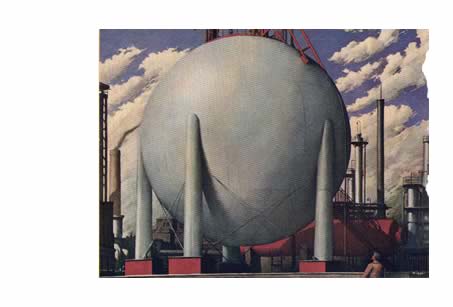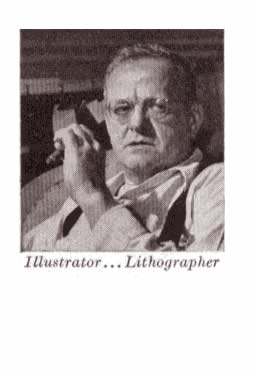| Riggs'
work for FORTUNE (Coney Island, and New York Police,
demonstrate the high water mark of American figurative art. His hard,
butch style with an edge of the grotesque fitted well into the pages
of FORTUNE editorial, and also into the advertising content of the
rest of the magazine. Sadly his work became increasingly unfashionable
in the fifties, and in the last years of his life he was in poor health
and much neglected. Through his old friend Benton Spruance he got some
teaching in the Illustration course at the Philadelphia College That
great supporter of Figurative Art, Philip Desind, supported him with
two retrospectives at his Gallery before Riggs' death in 1970.
He was
born in Decatur, Illinois 1896. It is said he ran away from home as
a lad, and travelled with a Circus, providing much dramatic narrative
subject matter for the future. Early education was at James Millikin
University Decatur and extended at the Art Students' League in New
York (1915-1917) where he arrived in time to be heavily influenced
by the Ash Can School. During the First World War,
he served with the Red Cross in France. He stayed in France after the
Armistice and studied at the Atleier Julien. He returned to the States
and settled in Philadelphia where his main employed was N.W.Ayer, the
giant advertising agency based there. He developed a financially rewarding
commercial career of depicting sturdy clean cut industrial types in
idealised landscapes and factories.By 1940 Riggs was earning between
$750.00 and $1500.00 a design for his commercial work, work it is said
he loathed.
Riggs was
a natural draughtsman, obsessed with Boxing and the Circus, where human
beings of muscular proportions could show off their bodies in theatrical
contexts. Around 1932 he had begun to make lithographs, of subjects
which were influenced by George Bellows, and drawing on his own experiences
in the Circus and as a Medic at war.
His driving
force outside the making of images was the lore of the Native Americans
examples of whose art he collected along with many examples of African
and Asian art. Reports have it that his wide ranging and ambitious
collection absorbed his income. "He
lives in a museum - alone - and likes it - keeps snakes as pets, is
fanatically interested in primitive things, and does all his creative
work at night,.. He doesn't make preliminary studies. He begins his
pictures by completely finishing the head of the central figure; until
this is rendered to his entire satisfaction he will not touch the work
elsewhere."
(E.W.Watson, Forty Illustrators and How They Work ,op.cit.
1946). His central theme, Riggs said, was "people and light"
He was
associated with the Germantown Boys Club. There are many tributes to
Riggs on the Internet from people who attended.
Bob Winder writes,
"Mr. Riggs was not only a friend to my brother
and myself but a teacher also. I learned alot about myself and how
to work with others and be part of a team. Being a member of the Boys
Club indians was a big part of my life and I can remember many great
times there. The strange food Mr Riggs would have for us. Remember
the chocolate covered ants. How about the rattlesnake meat. I can remember
him taking several of us to dinner down the road and the many trips
to his home with all that wierd stuff(remember we were early teens).
Mr. Riggs will always be a part of my memory. The shoemaker brothers
Mark Haskins and many others. That man help many of us keep out of
trouble in our youth."
In 1940, around the peak of his career as an illustrator, his drawings
commanded $750- $1500 each, and his name was as well-known in the trade
as that of Norman Rockwell. But Riggs loathed this commercial work, and
after 1950 he slid increasingly into obscurity, although revered by those
who knew him in the Philadelphia art world. When he died in 1970, he
was almost forgotten
IMAGES
ABOVE
01 a Hortonsphere
in the Wyandotte Glycol plant, advert for Wyandotte June 1950 21 x
26cms.
02 Spraying
the inside of a railway car to prepare it for the transportation of
caustic soda, advert for Wyandotte Sept. 1950 21 x 26cms
03 advert for Philadelphia Electric , June 1955 15 x26 cms
........................................................................................................................................................
 E.E.W.WATSON,
FORTY ILLUSTRATORS... 1948 E.E.W.WATSON,
FORTY ILLUSTRATORS... 1948
 Riggs'
portfolio on New York Cops FORTUNE July 1939 Riggs'
portfolio on New York Cops FORTUNE July 1939
 The
Zoot Suit c1938 The
Zoot Suit c1938
 Down
South Broad, from Esquire magazine c1938 Down
South Broad, from Esquire magazine c1938
 Coney
Island ,
from FORTUNE magazine date unknown Coney
Island ,
from FORTUNE magazine date unknown
 Raw
Materials, Philadelphia 1955 Raw
Materials, Philadelphia 1955
 Robert
Riggs, Disappointed Painter, Esquire
Magazine Dec.1947 Robert
Riggs, Disappointed Painter, Esquire
Magazine Dec.1947
|
SOME SOURCES
B. Bassham, The Lithographs of Robert Riggs (London, Philadelphia
and Toronto, The Art Alliance Press and Associated University Presses,
1986)
He contributed five lithographs to his father's book, A
Tale of the Illinois Country, 1934.
Stephen Coppel, The
American Scene, Prints from Hopper to Pollock (On
the Ropes, Psycopathic Ward) British Museum 2008
LIFE September
13, 1937, “The Prisoner of Zenda”
LIFE JULY
7, 1947, "The Duel" Hamilton met a violent death. |

















